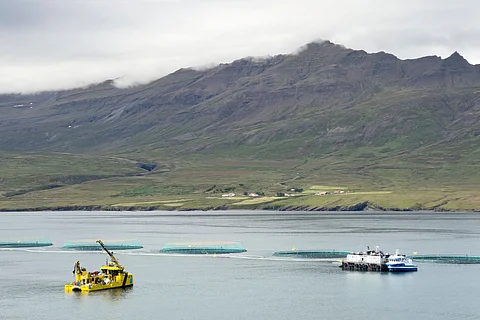

Salmon farm in eastern Iceland. Icelandic farmed salmon export value increased by approximately one-third in the first eight months of 2024 compared to the previous year.
Photo: Adobe Stock.
While a few days ago we published that Iceland saw a decline in fisheries exports in 2023, this week we have learned that the export value of aquaculture products in Iceland amounted to almost ISK 31 billion (EUR 207.8 million / USD 227.4 million) in the first eight months of the year, which is an increase of approximately 22% compared to the same period in 2023. According to the Icelandic dashboard of the fishing industry and aquaculture, Radarinn, most of this increase can be attributed to farmed salmon, which has hit record highs.
Specifically, between January and August 2024, the export value of salmon reached more than ISK 25 billion (EUR 167.6 million / USD 183.4 million). This is an increase of about one-third compared to the previous year, and, as mentioned, sets a record for this period.
Radarinn pointed out that this increase in the export value of farmed salmon this year is undoubtedly largely due to sea-cage farming. Although land-based farming is also expected to contribute to some extent, in recent years, most of the salmon production in Iceland has been carried out at sea, accounting for about 95% of all production.
In its report, the Icelandic dashboard of the fishing industry and aquaculture said that the development of sea-cage farming is well underway in the country even though only half of the production licenses are currently in use. As such, it is expected that it will continue to be the backbone of salmon production in the coming years. "Therefore, it will continue to be the backbone of salmon production in the coming years," it claimed.
However, Radarinn also noted that as significant development in land-based farming continues - both ongoing and planned - the dominance of sea-cage farming is expected to diminish over time. Nevertheless, they also caution that this development is costly and time-consuming, and there is still a long way to go to reach full production capacity.
It concludes that "The combination of sea-cage and land-based farming will undoubtedly give the industry broader foundations and a stronger position for the future."
As said above, ISK 25 billion of the total ISK 31 billion export value of aquaculture products in Iceland in the first eight months of the year corresponded to salmon. This represents approximately 81% of that total value. The remainder is mainly spread over three other products that have fared differently during the period.
Like salmon, Senegalese sole has also broken records. Its export value has never been higher, reaching almost ISK 1.2 billion (EUR 8 million / USD 8.8 million), an increase of about three times compared to the same period in 2023.
On the opposite, trout, which is mainly Arctic char, has seen a significant decrease in its export value which has fallen to 3 billion ISK (20.1 million EUR / 21.9 million USD). This is a 19% decrease compared to the same period last year. "Earthquakes and volcanic activity in Grindavik have played a major role in this decrease," Radarinn's report explained on the cause of that decline.
According to the Icelandic dashboard of the fishing industry and aquaculture, there has also been a 27% reduction in the export value of fertilized salmon eggs. Its value in the first eight months of the year amounted to around ISK 1.2 billion (EUR 8 million / USD 8.8 million), the same as Senegalese sole but, unlike it, in this case, the trend is downward.
Regarding the outlook of fish farming in Iceland - recently discussed at the Aqua Ice 2024 event - Radarinn closes the conclusions of its report on the export value of Icelandic aquaculture products by reflecting on what it described as a "bright future" for both, sea-cage and land-based fish farming.
"It is clear that Icelanders are facing significant opportunities for increased value creation in the economy through fish farming, both at sea and on land. It is therefore no surprise that virtually every economic forecast mentions aquaculture, whether in the context of exports or investment in industry," the report read.
As an example, the Icelandic dashboard of the fishing industry and aquaculture highlighted the recent forecast by Íslandsbanki's Analysis team, which predicts a considerable increase in aquaculture fish exports during the period 2024-2026.
The analysis also notes that this increase is expected to offset the decline in exports of other goods this year and contribute to overall export growth in the coming years. Likewise, the forecast also anticipates that business investment in Iceland will strengthen in the near future, particularly in relation to the substantial development of land-based farming.
The report also referred to the growing scope of aquaculture in Iceland as being very positive in the sense that it increases the diversity of the country's economic sectors, which favors Iceland's credit rating. In a recent press release from the credit rating agency Moody's, which raised the country's credit rating, the agency noted that the rating could be raised further if continued diversification of the economy reduces fluctuations in economic growth.
"Without a doubt, this is partly a reference to the increased activity in Icelandic aquaculture, although the agency does not specify any particular industry in this regard," Radarinn said. "Aquaculture is one of the fastest-growing export industries in recent years, with prospects for even greater growth in the coming years," it added.
